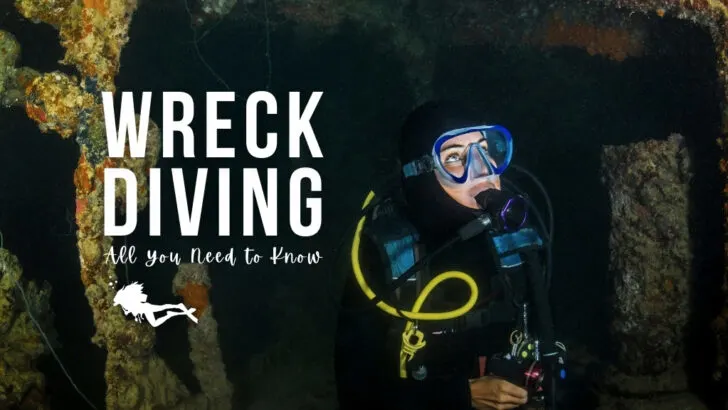We slip into an entirely different world any time we dip under the surface, but exploring underwater relics takes that to a whole different level. Wreck diving provides a unique window into maritime history, revealing secrets from times gone by.
Wrecks can also enhance biodiversity, so the sites are often teeming with life. On top of that, there are wrecks all over the world. This means that wreck divers have plenty of sites to explore – even when they’re far from coral reefs and seagrass meadows.
There are different ways you can explore sunken vessels while scuba diving. The most extreme forms require extensive training and come with serious hazards. Yet, for many divers, the chance to scuba through sunken museums is worth it.
Here, we’ll run through everything you need to know about wreck diving. And, for those of you who can’t wait to go on your next wreck adventure, we’ll also highlight some of the best places to go wreck diving.
What is wreck diving?
People usually associate wreck diving with shipwrecks. However, the term ‘wreck’ can refer to several things that have been damaged or destroyed.
For instance, it’s possible to explore wrecks of cars, planes and even buildings, as well as ships. Wrecks are often the result of a catastrophic event, like a ship sinking or a plane crashing. However, vehicles and vessels can be sunk deliberately, forming what is known as an ‘artificial wreck’.
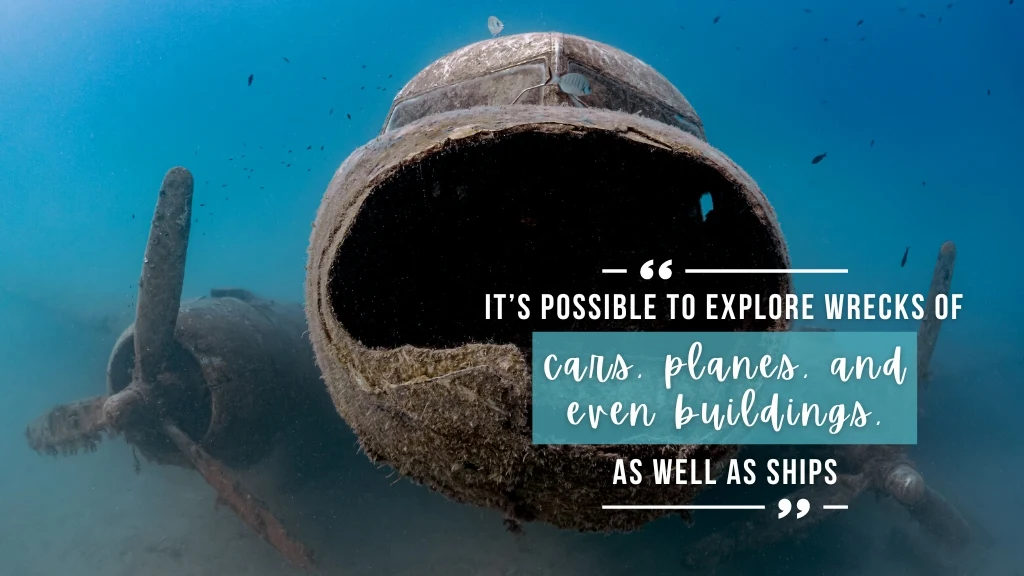
Artificial wrecks are typically placed in locations lacking other features. They are used to encourage underwater tourism, and they can support marine life in several ways. For instance, they can act as a substrate for algae to settle, and they can provide shelter for small creatures.
Wreck dives are typically broken down into three categories:
- Non-penetration dives – divers swim above and/or around the wreck, but they don’t go inside. This is the most basic form of wreck diving.
- Limited penetration dives – divers enter certain areas that are illuminated by natural light with visible exits. This is known as areas within the ‘light zone’.
- Full penetration dives – divers venture into the interior of the wreck, beyond the light zone. This is the most extreme form of wreck diving and is sometimes referred to as ‘advanced wreck diving’.
Is wreck diving dangerous?
Of course, wreck diving comes with risks, especially full penetration diving. In fact, full penetration diving is the most dangerous form of wreck diving. This is why it is classified as technical diving and requires specialist training.
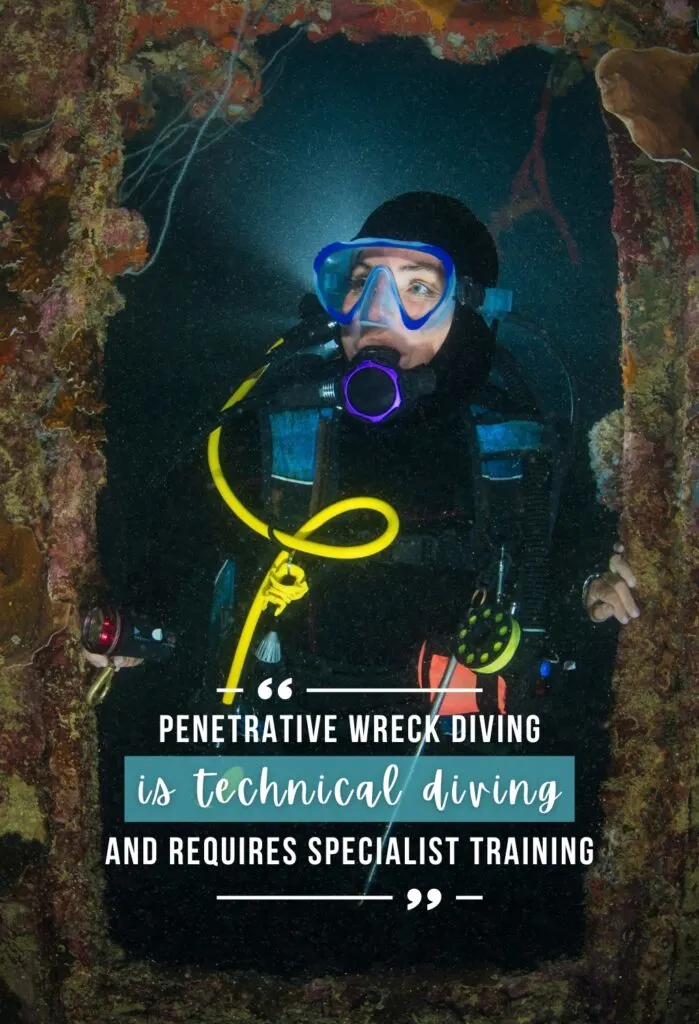
However, like all types of diving, many of the risks associated with wreck dives can be mitigated with proper training and by following safety guidelines.
What training and experience do I need for wreck diving?
The level of training you’ll need depends on the type of wreck diving you want to do.
Non-penetration and limited penetration dives
Technically, non-penetration diving doesn’t require specialised wreck diver training. Some tour operators may even take Open Water divers on this type of dive as long as the site is suitable. For instance, Open Water divers could explore the outside of a wreck in a shallow, sheltered site with good visibility.
Despite this, non-penetrative diving does come with some risks and hazards, such as entanglement and sharp objects. We therefore recommend that you wait until you’ve mastered the basics of open water scuba diving before going anywhere near a wreck.
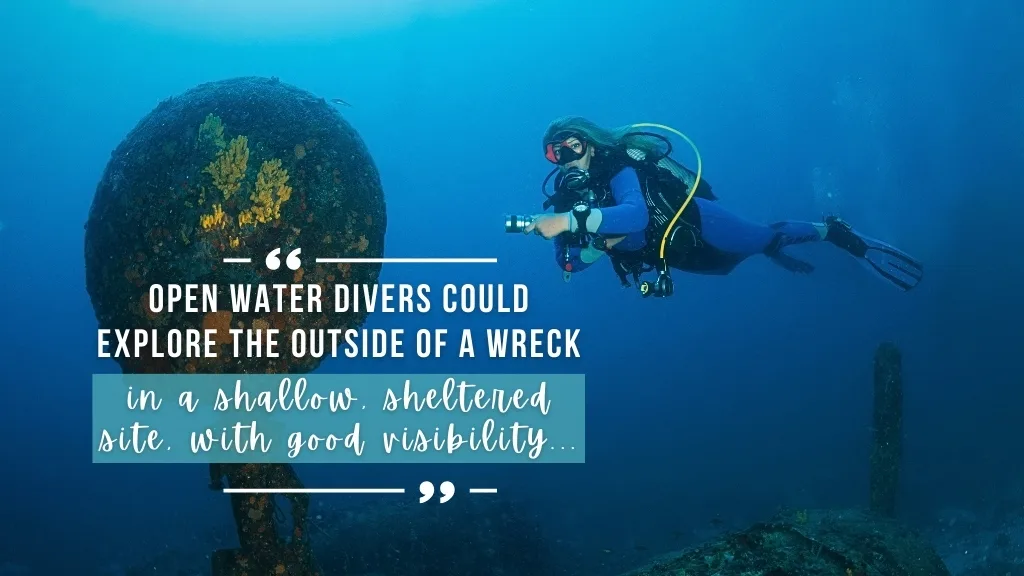
In fact, the best way to prepare for both non-penetrative and limited penetration wreck dives is through a wreck diving specialty course. Courses typically cover special finning techniques, use of lines, reels and other bits of equipment, and how to overcome problems associated with wreck diving.
There are plenty of courses out there, and most don’t require extensive diving experience. For instance, neither the PADI or SSI Wreck Diver specialty courses require an Advanced Open Water certification.
Note that not all speciality courses will include a limited penetration dive, and for some courses it may be optional. Most importantly, taking a recreational Wreck Diver speciality course will NOT certify you to penetrate wrecks. Read on to learn about the further training options for this.
Full penetration dives
If you’re ready to explore beyond the light zone, you’ll venture into the domain of technical diving. The TDI Advanced Wreck Diver course isn’t for the fainthearted, but it’s essential for anyone wanting to learn how to penetrate wrecks safely.
During the course, students will learn the correct methods for locating and planning a full penetration dive as well as how to use advanced wreck-diving equipment.
What equipment do I need for wreck diving?
During your training, your dive instructor will supply some, if not all, of the gear you need to wreck dive. We recommend making a note of the equipment they use – it might help you decide which equipment you’d like to purchase or hire in the future.
The gear you’ll need will depend on where you’re diving, but here are some key items:
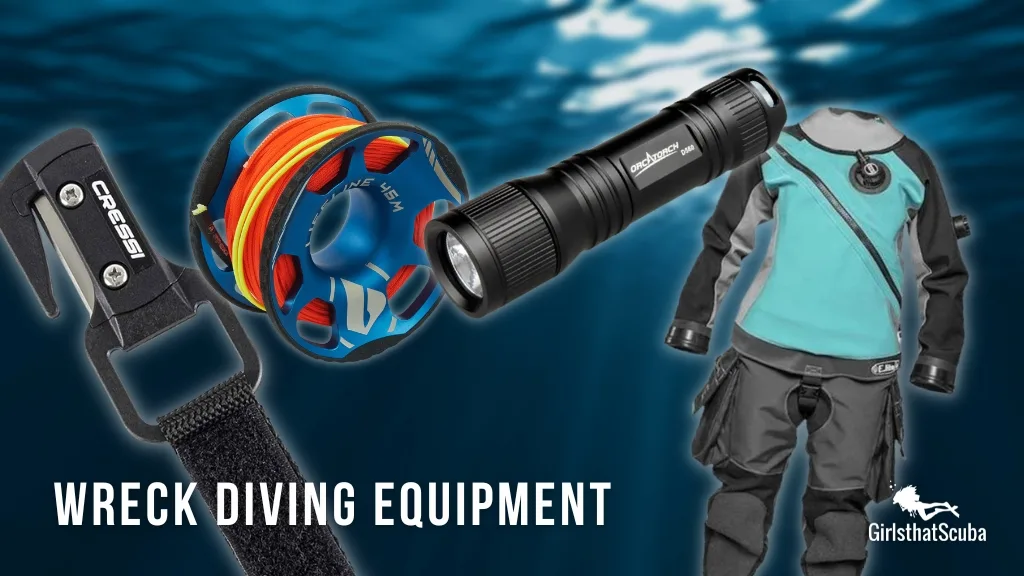
Knife or Cutting Tool
Wrecks often contain catch debris, fishing lines, ropes, or cables as they float by. These materials can entangle divers, so make sure you have a dive knife with you to free you (or your buddy) if needed.
Dive Lights
Proper underwater lighting is vital for avoiding hazards and navigating during a wreck dive, especially beyond the light zone. Full penetration wreck divers, like cave divers, often carry at least three torches to make sure that they’re not left in the dark.
Drysuit
Many wrecks are found in countries with cold waters or at depths, where you lose heat faster than near the surface. This can make dry suits essential for some wreck dives.
If possible, we recommend buying your own – a tailored fit minimises potential leaks that could disrupt your dive. Dry suits are an expensive bit of kit, so make sure you check out our guide to the best women’s dry suits before you buy one!
Spools
During penetration dives, divers use spools to deploy lines that act as physical guides back to the entry point. This is a crucial bit of gear, so make sure you test it out before you head to a wreck.
Where should I go wreck diving?
Whether you’re a newbie to wreck diving, enjoy some casual light zone dives, or like exploring the depths, there are heaps of dive sites out there for you.
It’s tricky to pick favourites, but here are a few of the top dive sites around the world to inspire your next trip:
Bermuda
Shrouded in mystery for centuries, and boasting agreeable weather year-round, Bermuda is a great place for wreck diving. Unusually, there are plenty of sites to choose from, so it’s an ideal place for beginners to acquaint themselves with wreck diving.
Egypt
Egypt’s eastern shoreline borders the Red Sea, which is known for its coral, marine life and, of course, wrecks. One of the most popular ways to explore the Egyptian Red Sea is on a “Northern Wrecks & Reefs” liveaboard route.

Probably the most notable wreck is the SS Thistlegorm – a British cargo ship that was sunk by a German bomber aircraft during WW2.
The Maldives
Is there anything the Maldives doesn’t have? As well as an abundance of marine life, white sandy beaches, and thriving coral reefs, the Maldives also has some awesome wreck dives – check out the best ones here.
Chuuk (Truk) Lagoon, Micronesia
Once you’ve got some wreck diving experience under your weight belt, this wreck diving hotspot will soon make its way onto your diving bucket list. Whilst some wrecks are accessible by recreational divers, you’ll see the best of Truk Lagoon if you work your way up to technical wreck diving. The beautifully preserved WWII wrecks are well-worth the tricky journey to get to Micronesia!
The Philippines
Forming the northern tip of the Coral Triangle, the Philippines is famed for its impressive coral and ocean giants. But did you know it’s great for wreck diving too?
In particular, Coron Island is home to various Japanese wrecks that were sunk during WW2.
Turkey
Türkiye has plenty of regions offering top-notch wreck dives. The Gallipoli Peninsula is in North-West Turkey, not far from Istanbul. It’s oozing with history above and below the water and is home to an impressive 19 wrecks.
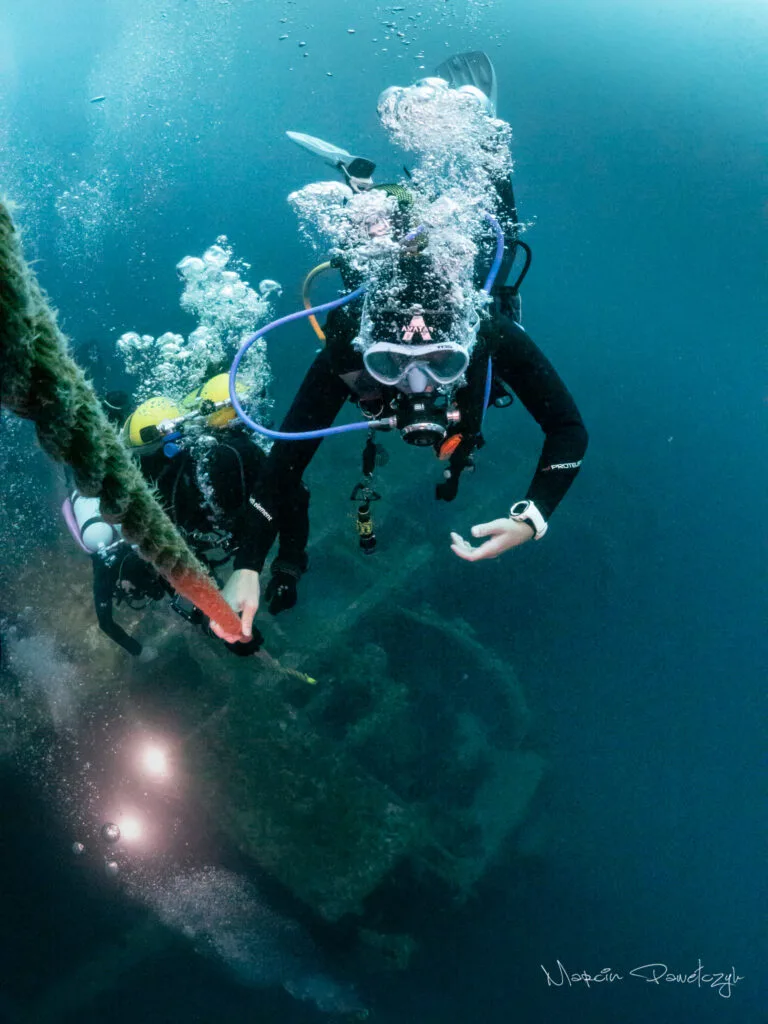
On the southern coast, there are plenty of coastal towns with vibrant diving communities. If you’re keen to escape the crowds, Kaş is a laid-back town with plenty of real and artificial wrecks to explore. The sites vary in depth, so you’ll find something for all abilities.
Have you tried wreck diving yet? Join us in the Girls that Scuba Facebook group and tell us about your favourite wreck destinations!

About the Author
Rose has spent the last few years living in Europe, the Seychelles and Kenya, working as a dive instructor, writer and conservationist. She’s back in the UK at the moment and is slowly acclimatising to cooler waters!

